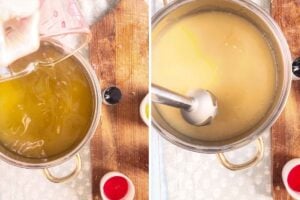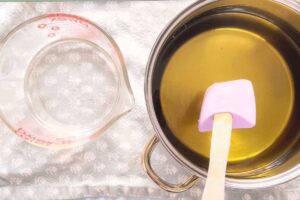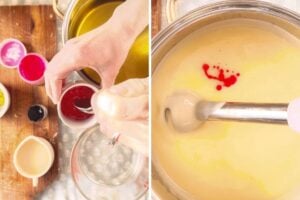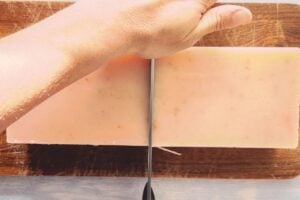Grapefruit Soap Recipe
Blend a simple soap base with citrus zest and grapefruit essential oil. You'll love this one.
Equipment
- safety equipment (goggles, gloves, mask)
- Thermometer
- Non-reactive containers
Ingredients
- 4.27 ounces lye
- 7.5 ounces water
- 2.5 ounces grapefruit juice
- 11 ounces olive oil
- 11 ounces coconut oil
- 6 ounces shea butter
- 2 ounces castor oil
- 2 teaspoons grated grapefruit zest
- 3 tablespoons of grapefruit essential oil
Instructions
- Prepare the lye solution. Wear your gloves, goggles, and mask, and work in a well-ventilated area. Then, using a digital scale, measure the lye and water separately in non-reactive containers. Next, slowly add the lye to the water (never the other way around) and stir until completely dissolved. The solution will heat up due to a chemical reaction, so be cautious of the heat and fumes. Set the lye solution aside in a safe place to cool to about 90-100°F.
- Melt and measure the oils: Measure all oils (olive, coconut, shea butter, and castor oil) into a pot or heat-safe container. Then, gently melt the oils over medium-low heat until fully combined. Once melted, remove from heat and allow the oil mixture to cool to 90-100°F.

- Add the grapefruit juice. Make sure the lye solution and oils are at similar temperatures (within 10 degrees of each other), around 90-100°F. Then, carefully add the grapefruit juice to the lye solution. Stir gently. The solution may turn orange—this is completely normal.

- Blend the lye solution with the oils. Pour the lye solution into the melted oils slowly. Use a stick blender to mix until the soap mixture reaches trace—a pudding-like consistency where the mixture leaves a trail when the blender is lifted.

- Add the color, fragrance, and zest. At trace, stir in the grapefruit zest and essential oil by hand. If using colorants, blend them with a small amount of oil before adding them for a smooth distribution. Pour the soap batter into your prepared mold immediately, smoothing the surface as needed.

- Gel phase. Preheat your oven to its lowest setting (around 170°F or “warm”). Turn off the oven and place your soap mold inside for about 1 hour. This step encourages the gel phase, which deepens the soap’s color and texture. Leave the soap in the oven to set for 24 hours, undisturbed.
- Unmold and cure. Carefully remove the soap from the mold and cut it into bars. Then, allow the bars to cure in a well-ventilated space for at least 2 weeks. For a harder, longer-lasting bar, extend curing to 4 weeks.

Notes
Before you start, gather all your tools, ingredients, and safety gear. Soap-making can go fast once you begin, so organizing will help you save time and avoid mistakes.
Even if you’ve made soap before, wearing gloves, goggles, and long sleeves is important. Just a little splash of lye solution can cause serious burns, so always put safety first.
Old or poorly stored lye can lose its strength and affect your soap. Use fresh, good-quality lye and keep it in a sealed container in a dry spot.
Strain the grapefruit juice to eliminate any pulp, as this can make the texture uneven. Use a fine grater and skip the white pith for the zest since it’s bitter and won’t give you the fresh scent you want.
Tap water might have minerals that could mess with your soap, so it’s best to use distilled water for a cleaner and more consistent result.
Silicone molds are flexible and make it easier to remove your soap without damaging the bars. If you’re using a wooden mold, line it with freezer paper to help take the soap out more easily.
Want to try something new? You can add some natural mica powder for color or swap out the essential oil for another citrus option, like lemon or lime. Just keep the total amounts of oil and liquid the same.
If experimenting with new ingredients, make a small test batch first. This way, you can make sure everything works well together and save time and materials if you need to make changes.